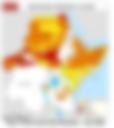- COVID-19 cases continue to rise across the region, leading to the loss of lives, disruptions to livelihoods and slowing down of national economies. The combined impacts of the COVID-19 pandemic, desert locust invasion, macro-economic crises, conflict and insecurity, and widespread flooding are driving significant food security and nutrition deteriorations across the region.
- As of July 2020, an estimated 32.8 million people in 8 of the 13 countries covered by the FSNWG in the eastern and central Africa (ECA) region were severely food insecure (IPC Phase 3 or worse) and required urgent food assistance. Of these, nearly 29 million are from five of the eight IGAD member countries.
- Due to the transboundary nature of the ongoing shocks, it is highly likely that there are additional food insecure people in the countries not covered under the current (July 2020) analysis. Additionally, urban populations have been disproportionally hit hard by the pandemic due to a high proportion who have abruptly lost their livelihoods.
- The newly launched IGAD Food Security and Nutrition Response Strategy projects that in the context of these multiple shocks, the number of food insecure people in need of food assistance among Member States could double to about 50.6 million through December 2020 in the absence of appropriate response interventions.
- There is concern over an increasing number of children under the age of five years that could suffer from wasting due to the economic impacts of the COVID-19 pandemic. The COVID-19 pandemic is also expected to increase other forms of child malnutrition, including stunting, micronutrient deficiencies, and overweight.
- The lagged effects of COVID-19 control and containment measures have affected trade on both the supply and demand sides, significantly reducing regional cross-border trade in staple foods during the second quarter of 2020. For instance, regional maize trade was 58% below the five-year average.
- South Sudan, Sudan, Ethiopia and Somalia are experiencing enhanced rains with localized flooding. Preliminary forecasts project an increased probability of La Niña conditions during the OND season lasting through January 2020. It is worth noting that La Niña is usually associated with depressed rains in parts of the ECA region, and often results in drought conditions over much of Kenya, southern Somalia, southern Ethiopia, eastern and central Uganda and northern Tanzania during the October-December (short rains) season.
- The desert locust situation remains a critical threat to food security and livelihoods across the region. Notably, Ethiopia has become the epicenter of desert locust infestation, with arrivals from Kenya and Yemen, aggravating the situation. In addition, summer breeding is imminent in Sudan and northern Ethiopia, increasing the risk to the ongoing main cropping season.
- As of July 2020, there was a 67% funding gap for humanitarian action in the region, including COVID-19 related emergency appeals.
- The East, Horn and Great Lakes (EHAGL) region is host to some 4.6 million refugees and asylum seekers, the majority (2.3 million) from South Sudan. A further 8.1 million people are internally displaced in the region (excluding those from DRC and CAR), as a result of conflicts and natural disasters.
Tags:
Food Security
,
Nutrition




